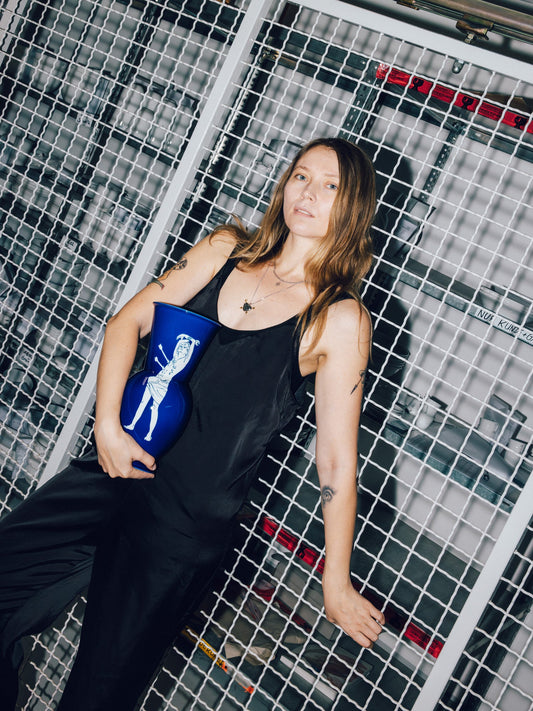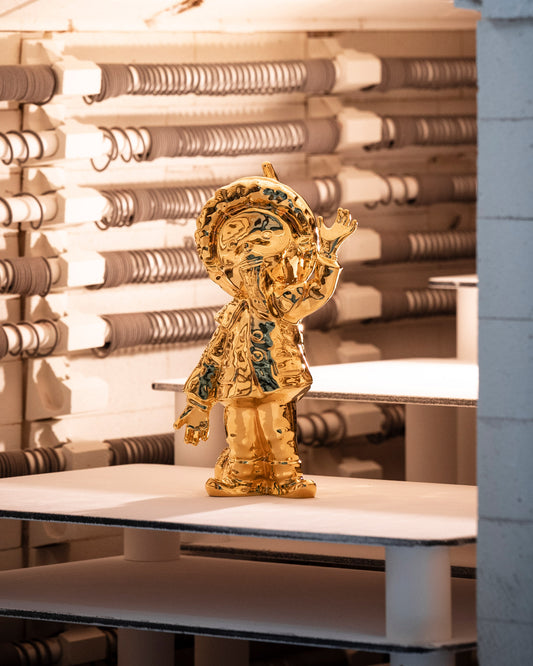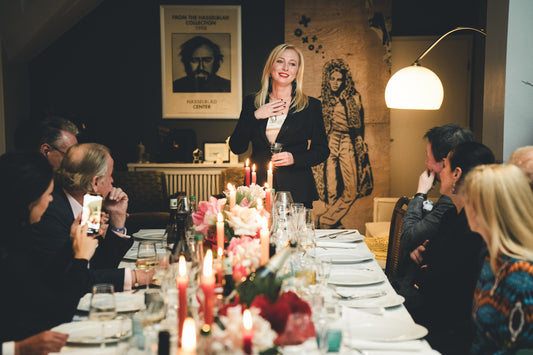SOUR-CUCUMBER ZEITGEIST: ARTIST CHARLOTTE ADAM PAINTS HEARTY MEALS AT KPM
"Disneyland for adults!" - is how artist Charlotte Adam describes her guest appearance at the KPM Meistermalerei. In this interview, she reveals what inspired her Bespoke collection, how porcelain is different from paper and why eating can be emotional for her
Artist Charlotte Adam at the KPM Manufaktur
Illustrations on white
KPM means family and tradition to me, my mother collects KURLAND for as long as I can remember. It was always on our table at Christmas and on festive days, and today, when my sisters and I come home, it's there from breakfast to dinner. That's probably why I'm not necessarily a Mix&Match fan, I like it when a service is complete. Our family love of KPM has also led to my mother and I attending several workshops at the Mitmach-Manufaktur together, which was a great pleasure!
That means you already knew the porcelain "canvas" a bit. What is special about painting on porcelain and not on paper or textiles?
It is simply a different feel, a different surface structure. It also makes a difference whether it's porcelain or ceramic, fired or not. But at the end of the day, it's just a matter of getting used to it and I enjoy rethinking things. I usually work with brushes and acrylics and now I work with oil and pigments, pen and brush. For me personally, painting porcelain is more illustrative than traditional painting.
Just take it with you!
On the first day, I have to admit, I was incredibly excited. I had a conceptual idea, but I wasn't quite sure what exactly I was going to do - especially as I had no idea how many and which pieces I would be allowed to paint and how much I would be able to do. And then suddenly it was "Take away, just take away!" and I had a huge selection, the whole table was full!
And then?
Then it was mainly the conversations with the painters that got me further, who had so many helpful tips that made me think and inspired me. And then I was suddenly able to develop quite a pace and became relatively fast and I lost my initial "fear of contact". Of course, also because I knew I only had a certain amount of time to finish, so I couldn't think about every stroke. I then drew rough outlines in pencil and then got to know different techniques. Sometimes I had to burn in between so that I could hold the pieces securely in my hand. Or to apply another layer of paint without damaging the other - that means waiting a day before continuing. These are processes that take a certain amount of time and that I wasn't aware of before.
How would you describe the atmosphere in the painting?
It was great! It was very special for me to be welcomed so warmly - and also: so nice to sit together with so many women. I always work alone in my studio, so it's been a long time since I've been in a creative space with other people. The atmosphere is very collegial and loving and the smell of the oils and colors creates a very special atmosphere in the rooms.
What was your best encounter here? Or the most exciting discovery?
Everything. It was like a week in an adult Disneyland for me. Something happened every day, which was great. Whether logistics, production or painting - the human interaction here is very warm. What I will remember most are the personal stories of the painters, who told me about their many years of experience, proudly presented their favorite projects and shared memories from the past. I really enjoyed this exchange.
Culinary art: The currywurst bowl with fries for ever
Aha, a pickle
You are a painter, you are known for large-format interior still lifes and humorous, almost fashionable small formats. But you are also working on another, rather unknown series of paintings that is very close to your heart.
I have been painting emotions with a face for 15 years. The series developed from an abstract self-portrait. The pictures have no name and, in contrast to the interior pictures painted over weeks, they are created very quickly and expressively. Sometimes it takes ten minutes, sometimes two hours, but rarely longer than half a day. They are snapshots that I can't stay in any longer, thinking about them would destroy them. These emotions also play a role in the KPM objects.
You called your collection "Eating Emotions".
Yes, because it was ultimately similar with the porcelain. As I said, the time pressure made the work more illustrative, more expressive. These are expressions that I stored in my mind, which I then transferred to the porcelain. Even if at first you might just think: aha, a pickle. I associate the term emotional eating, from which I derive "eating emotions", with food that you don't just eat to satisfy your actual hunger for food. For example, eating dinner with friends and family, where all kinds of different emotions come up at the table. But also eating out of frustration, as we know it from heartbreak, for example.
Your pieces have a front and a back. If you turn them over, you can read little statements on the bottom like "I like Dish" or "I miss Dish".
Dish is English for dish. The emotions are given an expression and you can take them in with the help of the porcelain, literally. You don't deny yourself the emotion, but internalize it, at best consciously and with pleasure. In doing so, you can perhaps also transform negative emotions into something positive. Without over-aestheticizing the whole thing. But this creates a process, something I can make friends with and make peace with. Something that I can also look at with a certain wink and reflect on in a humorously aesthetic way.
KURLAND has always been there." Charlotte Adam grew up with KPM porcelain and has now combined her favorite classic with her favorite dishes.
"Every emotion can emerge whenever it wants. It's a surprise because it's on the back," reveals the artist.
Charlotte Adam's "Eating Emotions" series was created as part of a residency and initially only consists of individual pieces that can be requested from the artist or commissioned bespoke.
More from Charlotte Adam on Instagram.


